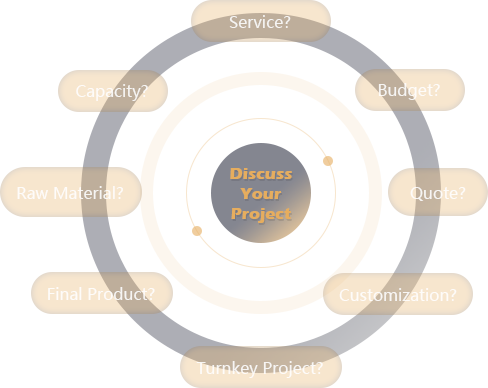The RDF (Refuse Derived Fuel) drying line is core equipment for the resource recovery and reduction of solid waste. Through a systematic drying process, it transforms high-humidity RDF raw materials into a high-quality fuel with stable calorific value that is easy to store and transport. The entire system integrates multiple units, including raw material conveying, agitation, drying, dust removal, and finished product collection, and features a high degree of automation, low energy consumption, and strong environmental performance.
The working principle of the RDF drying line follows the core logic of "agitation - heat exchange - separation - purification," with each unit working in synergy to complete the drying process. The specific process and principles are as follows:
1. High-humidity RDF raw materials (typically with a moisture content of 30%-60%) are transported via a conveyor belt to the pre-treatment stage, where they are first screened to remove impurities such as metal and stone to prevent damage to subsequent equipment. The raw material then enters a high-speed disintegrator, where rotating teeth break up any agglomerated RDF into uniform particles (typically 5-30mm in size). This increases the contact area between the material and the hot air, paving the way for efficient drying.
2. The pretreated RDF particles are conveyed by a screw conveyor into a rotary dryer (the core drying equipment). Simultaneously, clean hot air (150-250°C) generated by a hot air furnace (which can use natural gas, biomass fuel, or its own exhaust gas as a heat source) is introduced into the dryer through a hot air duct. The dryer drum rotates slowly at an angle, and internally installed lifting plates continuously lift and disperse the material, ensuring full contact with the countercurrent or cocurrent hot air. Through convection and radiation, moisture in the material is rapidly evaporated.
3. The dried RDF product, along with the dusty, hot, and humid exhaust gas, enters a cyclone separator, where centrifugal force separates the majority of the solid product from the gas. The finished product then passes through a discharge valve and is stored in a finished product bin. The separated exhaust still contains a small amount of dust and volatile organic compounds (VOCs). It then passes through a bag filter (which captures fine dust with a dust removal efficiency exceeding 99.9%) and an activated carbon adsorption device (which removes odors and harmful gases). The purified exhaust meets national emission standards and is discharged through a chimney by an induced draft fan.
4. The entire production line is equipped with a PLC control system. Sensors monitor the dryer's temperature, humidity, material flow, and exhaust emission indicators in real time, automatically adjusting the hot air temperature, drum speed, and material feed rate to ensure stable drying results while reducing manual operation.

Applicable Materials for the RDF Drying Line: The RDF Drying Line is designed specifically for processing various types of high-humidity RDF (RDF) derived from solid waste. Specific applications include:
1. Municipal Waste-Derived RDF: RDF is produced from sorted municipal waste (removing inert components such as metal, glass, and masonry) through crushing and mixing. These materials have a high initial moisture content (40%-60%) and complex composition. After processing through a drying line, the moisture content can be reduced to below 15%, and the calorific value increased to 3,000-4,000 kcal/kg, making them suitable as alternative fuels for boilers and incinerators.
2. Industrial solid waste-derived RDF: This includes RDF made from industrial solid wastes such as paper mill sludge, printing and dyeing sludge, leather waste, plastic scraps, and wood processing waste. For example, paper mill sludge RDF typically has a moisture content of over 50%. Drying not only reduces transportation costs but also allows for energy recovery through incineration. Plastic and wood RDF maintain a stable calorific value after drying and can be used for co-processing in cement kilns.
3. Agricultural waste-derived RDF: This material is made from agricultural waste such as straw, rice husks, peanut shells, and livestock and poultry manure, through pulverization and extrusion. The moisture content of this material fluctuates significantly (30%-50%) depending on the season. Drying can prevent mold during storage and improve combustion efficiency, making it suitable for biomass power plants or small industrial boilers.
4. Commercial waste-derived RDF: RDF is made from discarded packaging (cardboard, plastic packaging) and kitchen waste (after dehydration pretreatment) generated by shopping malls, supermarkets, and catering establishments. This material contains a high proportion of organic matter. Drying eliminates odors and converts it into a stable fuel, thereby reducing the amount of commercial waste and maximizing its resource utilization.































